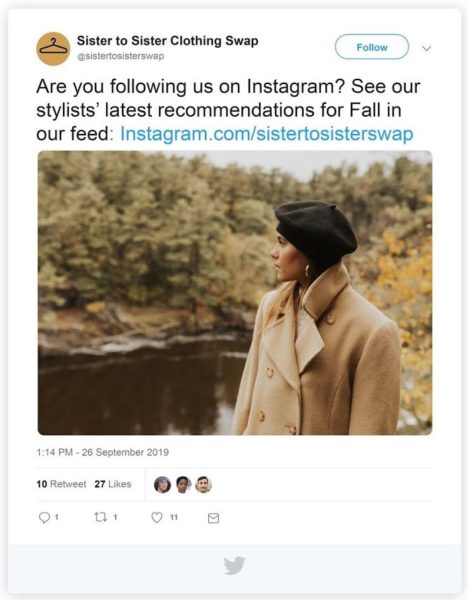
You may be asking yourself if you need another social media account. After all, you’ve set up your Facebook page and maybe even figured out how best to work Instagram as a nonprofit. That’s why Twitter is your next best marketing move.
Twitter has its own personality and potential. It offers you the ability to engage your community on the events and issues that matter to them. It’s a virtual town hall, a chance to attract younger donors, and a way of staying connected with your base.
Another reason to learn how to use Twitter effectively for nonprofits is its proven ability to convert: the number of people who take some sort of action after engaging with nonprofits on Twitter is 55 percent.
Take advantage of this resource and put Twitter to work for you. This article will go over:
- Setting up your account for success
- Posting dynamic and interactive content
- Building and interacting with your Twitter community
- Asking for donations
After mastering these basics, you’ll be able to customize and refine your Twitter strategy to best achieve your goals.
Setting up your account for success
While having a Twitter account with your organization’s basic information helps you make sure that people who look for you can find you, your Twitter account should be much more than a business listing. Here are some of the best practices as you get going.
Get organized
What do you hope to accomplish with Twitter? How much time do you have to give it? Be realistic.
Integrate Twitter into your nonprofit’s greater social media strategy, identifying which tasks are best for which platform. Social media goals fall into three main categories:
- Awareness. Make people aware of your organization.
- Engagement. Elicit engagement such as following an account, visiting your website, or signing up for an email list.
- Action. Convert that engagement into action that benefits your nonprofit such as volunteering or donation.
Remember that Twitter is a fairly informal site that allows for a more spontaneous style. It is even more present-focused than other social media networks, giving users the opportunity to immediately engage with news and events.
Get started
The most important thing you can do is to begin. Here are some easy steps for Twitter newbies:
- Create an account. Use a striking image and write a bio that captures your mission. Link to your website for those who want to learn more about you.
- Send a tweet. Introduce yourself to the Twitterverse. Don’t overthink it. Just get some content up to assure both people and computers that you’re a real human being.
- Invite your network to follow you on Twitter. You can use Constant Contact’s email services to encourage your base to engage.
- Start following people. You should pay attention to similar businesses, and important figures in your field, so that you can see what they do right. You can even follow Twitter’s own @nonprofits for the best examples of Twitter for nonprofits.
- Save searches and create lists. Twitter enables both of these functions. Start organizing your feed from the beginning, making it easier to return to topics and keep track of people.
You’re now ready to start focusing on content.
Posting dynamic and interactive content
The ultimate aim of using Twitter for nonprofits is the cultivation of relationships. But how can you inspire people to engage with your content rather than scrolling right past it?
Be inviting
The first step in eliciting engagement is giving people a way to engage.
- Ask questions.
- Invite comments and retweets.
- Set up a Twitter poll about what to do for your next event.
- Link to sites that you think will interest your audience.
- Set up a contest or raffle in which followers can participate.
Monitor your account and don’t forget to reply when the conversation demands it.
Be relevant
Twitter users want the latest updates and the most recent conversations. It leaves Facebook and Instagram in the dust when it comes to users that use it as a source of news.
Post on emerging policies or events that affect your organization. Follow influential and innovative thinkers and speak to points they raise.
Be local
Develop relationships with your local community. You can highlight events, give a shout-out to a nearby business, or even cheer for local teams.
While Twitter also lets you reach further afield than you could otherwise, most nonprofits rely on a local base. Stay connected and others will want to connect to you.
Be entertaining
Post pictures and videos. Twitter makes it easy to add pictures from your other accounts, maximizing the number of people that see them. And video has become the content king in online marketing.

Building and interacting with your Twitter community
While it’s certainly nice to stay connected with an already loyal base, you likely want to use Twitter to grow your community. A few tips to help you develop your network:
- Make tweets actionable. Invite people to share or comment.
- Interact with other users. Comment or retweet. Instead of simply demanding engagement, demonstrate that you’re engaged as well. Be genuine. Don’t hijack other people’s threads as an opportunity for self-promotion.
- Use hashtags. In order to reach audiences interested in a certain area or topic, use hashtags. You can also create your own unique hashtag and ask people to use it when they post, allowing you to track the conversation.
- Tag people. Be sure to tag people associated with posted content.
- Live tweet during an event or participate in Twitter chats. This will immediately engage an interested audience.
Tweet regularly. You may not have the resources that will allow you to be a daily presence, but integrate Twitter into your social media calendar.
You don’t have to rely on making time on a busy and unpredictable day. You can schedule your posts in advance with Constant Contact’s social media tools.

Asking for donations
Twitter allows you to reach more people. The most important thing you can do to improve fundraising is to cultivate your community and relationships.
How to ask for donations on Twitter:
- Be clear and concise. What do you need and why? How can people help you meet this need?
- Create custom links that will take people directly to your fundraiser.
- Get your followers involved. Ask them to retweet fundraising posts, extending their reach.
- Provide regular updates on progress.
- Recognize donors and volunteers, showing your appreciation.
After the fundraiser is over, follow up with posts that show donors the effect they’ve had. Make them feel their impact, and they’ll be more likely to contribute to your next big event.
Start connecting
Think of Twitter as an opportunity instead of as an obligation. It allows you to connect with other people who care about the same things that you do. It supplements what you can accomplish through email marketing.
Moreover, you don’t need to be a social media savant to use Twitter for nonprofits. You just need a connection to the internet and a little practical advice. For more digital marketing guidance, check out The Download: Making Sense of Online Marketing for Community Services.
Constant Contact also regularly updates its blog with nonprofit-specific content. Or you can contact us for more personalized answers and recommendations.




